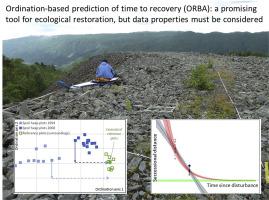当前位置:
X-MOL 学术
›
Ecol. Eng.
›
论文详情
Our official English website, www.x-mol.net, welcomes your feedback! (Note: you will need to create a separate account there.)
Dataset properties affect the performance of the ordination regression-based approach (ORBA) in predicting time to recovery
Ecological Engineering ( IF 3.8 ) Pub Date : 2020-06-01 , DOI: 10.1016/j.ecoleng.2020.105875 Inger Auestad , Knut Rydgren , Rune Halvorsen
Ecological Engineering ( IF 3.8 ) Pub Date : 2020-06-01 , DOI: 10.1016/j.ecoleng.2020.105875 Inger Auestad , Knut Rydgren , Rune Halvorsen

|
Abstract The globally increasing pace of ecosystem degradation makes it necessary to develop efficient restoration programmes. A reliable tool for estimation of the remaining time to recovery is an important component of such a programme. In this study, we explore the performance of the novel, ordination regression-based approach (ORBA) for prediction of time to recovery. We applied ORBA to a dataset of plant species composition data from ten spoil heap sites in S Norway, resulting from hydropower development. Five study sites were situated in the alpine and five in the boreal bioclimatic zone, the latter group showing large between-site variability of climate, time since disturbance (age) and restoration treatments. The vegetation of spoil heaps was recorded at two time-points, while that of the surroundings of each spoil heap was recorded once, to serve as a reference. We obtained time-to-recovery predictions based on ordination of the full dataset and of two data subsets that represented alpine and boreal sites, respectively. The vegetation of all spoil heaps became more similar to the vegetation of their surroundings over time. In many cases, linear models described the temporal pattern less well than asymptotic models. The latter models predicted slow recovery for all sites, but showed large variation in time to recovery among the boreal sites. In some of the boreal sites, we observed extremely species-poor plots and many infrequent species. Moreover, in one site we observed apparent mismatch between observed vegetation development and the underlying model of increasing similarity to surroundings. We ascribed these cases to suboptimal restoration practises, and for them, non-significant ORBA models resulted. Our findings support the conclusions of previous studies; that ORBA is a robust method for predicting time to recovery over a wide range of restoration projects. Its output – predicted time (years) to recovery – is easily communicated and may be useful in evaluating the speed and direction of restoration programmes. However, our results also demonstrate the importance of carefully assessing the properties of datasets (e.g. plotwise species richness) subjected to ORBA analyses.
中文翻译:

数据集属性会影响基于排序回归的方法 (ORBA) 在预测恢复时间方面的性能
摘要 全球生态系统退化的步伐越来越快,因此有必要制定有效的恢复计划。估计剩余恢复时间的可靠工具是此类计划的重要组成部分。在这项研究中,我们探索了基于排序回归的新颖方法 (ORBA) 的性能,用于预测恢复时间。我们将 ORBA 应用于来自挪威南部 10 个弃土堆场的植物物种组成数据数据集,这些数据来自水电开发。五个研究地点位于高山,五个位于北方生物气候带,后一组显示气候、自干扰时间(年龄)和恢复处理之间的较大差异。在两个时间点记录弃土堆的植被,而每个弃土堆周围的植被记录一次,作为参考。我们根据完整数据集和分别代表高山和北方站点的两个数据子集的排序获得了恢复时间预测。随着时间的推移,所有弃土堆的植被变得与周围的植被更加相似。在许多情况下,线性模型对时间模式的描述不如渐近模型好。后一种模型预测所有站点的恢复缓慢,但显示北方站点之间恢复的时间差异很大。在一些北方地区,我们观察到物种极其贫乏的地块和许多稀有物种。此外,在一个地点,我们观察到观察到的植被发育与与周围环境相似性增加的潜在模型之间存在明显的不匹配。我们将这些案例归咎于次优的修复实践,对于他们来说,结果不显着的 ORBA 模型。我们的发现支持了先前研究的结论;ORBA 是一种可靠的方法,可用于预测各种恢复项目的恢复时间。它的输出——预测恢复时间(年)——很容易传达,可能有助于评估恢复计划的速度和方向。然而,我们的结果也证明了仔细评估经过 ORBA 分析的数据集的特性(例如按图的物种丰富度)的重要性。它的输出——预测恢复时间(年)——很容易传达,可能有助于评估恢复计划的速度和方向。然而,我们的结果也证明了仔细评估经过 ORBA 分析的数据集的特性(例如按图的物种丰富度)的重要性。它的输出——预测恢复时间(年)——很容易传达,可能有助于评估恢复计划的速度和方向。然而,我们的结果也证明了仔细评估经过 ORBA 分析的数据集的特性(例如按图的物种丰富度)的重要性。
更新日期:2020-06-01
中文翻译:

数据集属性会影响基于排序回归的方法 (ORBA) 在预测恢复时间方面的性能
摘要 全球生态系统退化的步伐越来越快,因此有必要制定有效的恢复计划。估计剩余恢复时间的可靠工具是此类计划的重要组成部分。在这项研究中,我们探索了基于排序回归的新颖方法 (ORBA) 的性能,用于预测恢复时间。我们将 ORBA 应用于来自挪威南部 10 个弃土堆场的植物物种组成数据数据集,这些数据来自水电开发。五个研究地点位于高山,五个位于北方生物气候带,后一组显示气候、自干扰时间(年龄)和恢复处理之间的较大差异。在两个时间点记录弃土堆的植被,而每个弃土堆周围的植被记录一次,作为参考。我们根据完整数据集和分别代表高山和北方站点的两个数据子集的排序获得了恢复时间预测。随着时间的推移,所有弃土堆的植被变得与周围的植被更加相似。在许多情况下,线性模型对时间模式的描述不如渐近模型好。后一种模型预测所有站点的恢复缓慢,但显示北方站点之间恢复的时间差异很大。在一些北方地区,我们观察到物种极其贫乏的地块和许多稀有物种。此外,在一个地点,我们观察到观察到的植被发育与与周围环境相似性增加的潜在模型之间存在明显的不匹配。我们将这些案例归咎于次优的修复实践,对于他们来说,结果不显着的 ORBA 模型。我们的发现支持了先前研究的结论;ORBA 是一种可靠的方法,可用于预测各种恢复项目的恢复时间。它的输出——预测恢复时间(年)——很容易传达,可能有助于评估恢复计划的速度和方向。然而,我们的结果也证明了仔细评估经过 ORBA 分析的数据集的特性(例如按图的物种丰富度)的重要性。它的输出——预测恢复时间(年)——很容易传达,可能有助于评估恢复计划的速度和方向。然而,我们的结果也证明了仔细评估经过 ORBA 分析的数据集的特性(例如按图的物种丰富度)的重要性。它的输出——预测恢复时间(年)——很容易传达,可能有助于评估恢复计划的速度和方向。然而,我们的结果也证明了仔细评估经过 ORBA 分析的数据集的特性(例如按图的物种丰富度)的重要性。



























 京公网安备 11010802027423号
京公网安备 11010802027423号